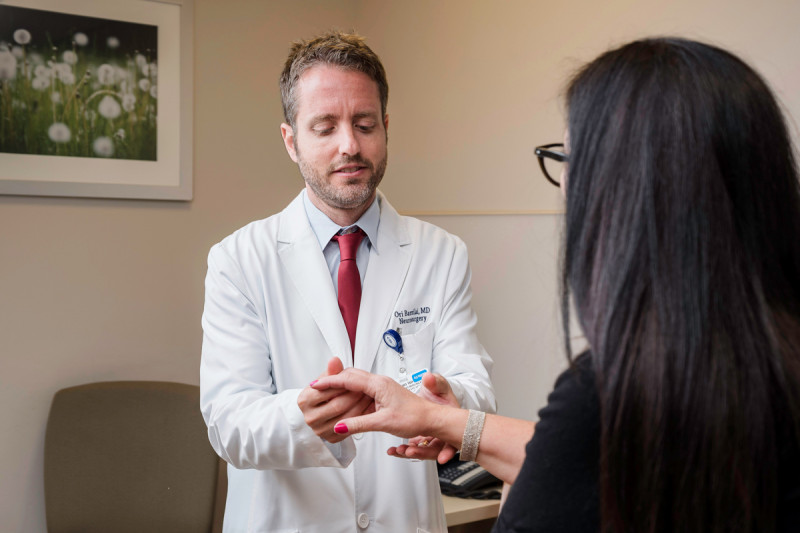
MSK’s new neurofibromatosis clinic makes it possible for patients to see multiple specialists, such as neurosurgeon Ori Barzilai, in a single visit.
Neurofibromatosis is a genetic disorder that often leads to tumors throughout the nervous system, including the brain, spinal cord, and nerves. The tumors are usually noncancerous, but they can cause disability and even become life-threatening.
In early 2019, Memorial Sloan Kettering launched a multidisciplinary center dedicated to improving neurofibromatosis treatment and research. The new center enables experts in various specialties to work closely together to provide better care and advance the field of study.
“Because neurofibromatosis predisposes people to tumors, it’s a disorder of great importance to our cancer center,” says MSK neuro-oncologist Anna Piotrowski.
Three Disorders
Neurofibromatosis is a general term used to refer to three disorders: neurofibromatosis type 1 (NF1), neurofibromatosis type 2 (NF2), and schwannomatosis. The genetic causes are different for each. All three can be inherited, but they can also result from a spontaneous gene mutation.
NF1 is usually apparent during childhood, while NF2 and schwannomatosis are typically diagnosed in adulthood.
There is a lot of variability in how the disease manifests itself — some people develop many tumors, others very few. The number and location of the tumors depends partly on the genetic characteristics of the disease.
Neurofibromatosis can be treated and managed, but there is no cure. The disease has been recognized for centuries — there are depictions of neurofibromatosis in the drawings of 13th-century monks — but no drugs have been approved by the US Food and Drug Administration to treat it. However, the field is changing rapidly.
“There has been a recent explosion of advances in neurofibromatosis treatment, both in potential drugs and in better imaging techniques,” Dr. Piotrowski says.
Regular Clinics
One important feature of MSK’s neurofibromatosis center is a clinic every two weeks that enables people to see multiple specialists in one visit, launched by Mark Bilsky, Chief of the multidisciplinary Spine Tumor Center.
“There’s a lot of expertise here in different disciplines, so when we bring them all together in the same room, it creates a huge benefit for patients,” says MSK neurosurgeon Ori Barzilai. “The neurosurgeons sit together with surgeons in other specialties, along with radiologists, pathologists, geneticists, and many others, and patients get rapid answers to their questions.”
The team, including Andrew Lin, another neurologist specializing in the clinical care of neurofibromatosis, also meets every two weeks at a tumor board. The enables them to present and discuss difficult neurofibromatosis cases and treatment options. “It’s a really good avenue for people to talk about these challenging cases because often with neurofibromatosis the best plan is not straightforward,” Dr Barzilai says.
Dr. Barzilai adds that he and other MSK neurosurgeons are increasingly using minimally invasive surgical methods — especially robot-assisted techniques — to treat neurofibromatosis when appropriate.
“People with neurofibromatosis often require multiple surgeries over their lifetime, so if we can keep it minimally invasive, that’s a big win for them,” Dr. Barzilai says. “MSK is one of very few places that can offer this benefit.”
Clinical Trials
At MSK, people with neurofibromatosis have access to a wide array of research studies sponsored by the Neurofibromatosis Clinical Trials Consortium.
“There are many encouraging therapeutic options being tested through the consortium,” Dr. Piotrowski says. “One drug, selumetinib, is showing promise for the treatment of NF1-associated plexiform neurofibroma, which is very exciting for these patients. These tumors are very hard to remove with surgery, and it is difficult to treat them safely with radiation.”
Selumetinib received Breakthrough Therapy Designation earlier this year from the FDA to treat NF1. The drug is also being studied in clinical trials for certain cancers, including non-small cell lung cancer and thyroid cancer.
A promising phase II trial recently tested the drug bevacizumab (Avastin®) in people with NF2-associated vestibular schwannomas. These are tumors that develop on the hearing and balance nerves leading from the inner ear to the brain.
“People with vestibular schwannomas on the hearing nerves who are not good candidates for surgery or radiation may benefit from this drug,” Dr. Piotrowski says. “Results from the study show that people receiving bevacizumab had either an improvement in hearing or no further decline for a prolonged period. This is quite significant for their quality of life.”
Another phase II trial, led by pediatric neuro-oncologist Matthias Karajannis, will test the drug crizotinib (Xalkori®) in children and adults with NF2 and progressive vestibular schwannoma.
Bringing Laboratory Findings to the Clinic
A critical step toward better treatments is understanding what happens in neurofibromatosis tumors that start out benign and then become cancerous. The Sloan Kettering Institute laboratory of Luis Parada, Director of the Brain Tumor Center, has a longstanding research interest in the development of NF1-associated tumors and it has developed genetically engineered mouse models that can provide essential information about what drives the tumors to become cancerous.
Ingo Mellinghoff, Chief of the Brain Tumor Service, Acting Co-Chair of Neurology, and physician-scientist in the Human Oncology and Pathogenesis Program (HOPP), is investigating gliomas that are associated with germline and sporadic mutations of NF1. In addition, physician-scientist Ping Chi is using cell, tissue, and mouse models to study the genetic and epigenetic changes that lead to the formation of certain NF1-associated soft tissue tumors.
MSK clinicians already use MSK-IMPACTTM, a DNA sequencing test, to determine which genetic changes make a neurofibromatosis tumor vulnerable to specific drugs. Recently, MSK researchers began using the test to compile a database of information about people with NF1 who go on to develop brain cancer. The genetic information is combined with other clinical information. The hope is that creating a molecular profile will shed light on what causes this more serious cancer to develop.




